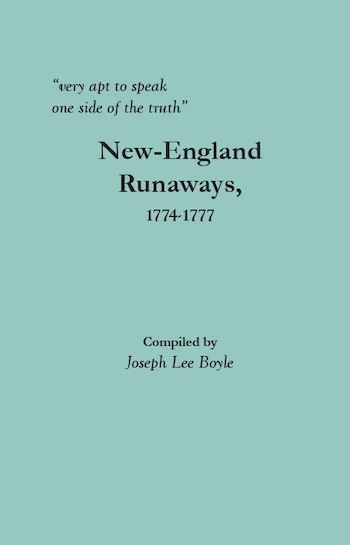The following book reviews were written by Bobbi King:
“Runaways” Volumes Continue Publication by the Genealogical Publishing Company
Joseph Lee Boyle, the prodigious researcher, compiler, and author, continues to output his extractions of historic advertisements placed into colonial newspapers by the owners of runaway servants, apprentices, military deserters, lawbreakers, errant spouses, and miscellaneous categories of persons on the run.
Each book has an introductory section offering details describing the newspapers searched, the information recovered, the indexing of all the names, the compiler’s efforts to transcribe the ads exactly as read, and examples of particularly notable persons and ads.
Each book has an index, including the several names used for one individual in a notice.
Some examples:
 RAN away from Capt. James Oliver of Boston, a Negro Man named Cambridge, about 27 Years old and Pockbroken, that has been used to work at the Baker’s Trade. He had on a new double breasted light coloured Cloth Jacket, with flat Metal Buttons, lined with blue Bays, and a great Coat and breeches of the same Cloth, or else a pair of blue Cloth Breeches, and a Seal-skin Cap. Whoever takes him up, and brings him to his abovesaid Master, shall have 40s. Reward, old Tenor, and all necessary Charges. And all Masters of Vessels are forbid carrying him off at their Peril.
RAN away from Capt. James Oliver of Boston, a Negro Man named Cambridge, about 27 Years old and Pockbroken, that has been used to work at the Baker’s Trade. He had on a new double breasted light coloured Cloth Jacket, with flat Metal Buttons, lined with blue Bays, and a great Coat and breeches of the same Cloth, or else a pair of blue Cloth Breeches, and a Seal-skin Cap. Whoever takes him up, and brings him to his abovesaid Master, shall have 40s. Reward, old Tenor, and all necessary Charges. And all Masters of Vessels are forbid carrying him off at their Peril.
The Boston Evening-Post, January 9, 1744. See The Boston Evening-Post, June 9, 1740. See The Boston Evening-Post, October 17, 1743.
WHEREAS Jane Williams the Wife of Jonathan Williams of said Beverly, hath run him in Debt, and squander’d away a considerable Part of his Estate; THIS is to caution all Persons whatsoever against trading with her, and to inform them, that her said husband will not pay any Debt she shall contract after this Date, as witness my Hand,
Jonathan Williams.
The Boston Weekly Post-Boy, January 9, 1744; January 16, 1744.
RAN away from the Ship Providence, John Parr Master, on the 9th of December, 1743, John Scudder, who if he will return to his Duty on board the said Ship in five Days from the Date hereof, he shall be kindly received, but if not, he shall be deemed a Deserter, and treated accordingly.
The Boston Evening-Post, December 26, 1743; January 2, 1744.
These are recent publications:
“Stiles himself a Prize fighter” New-York Runaways, 1706–1768
The majority of persons cited in this series are runaway servants, slaves, and lawbreakers, both men and women. Thirty newspapers were consulted.
“Fond of liquor, dancing and gaming” New-York Runaways, 1769–1783
Sixty-two newspapers were consulted.
“smooth tongued and deceitful” White New Jersey Runaways 1767–1783
The majority of persons cited here are white men and women runaways. Blacks whose names were in the ads are noted and included in the index. Forty-one newspapers were consulted.
“much given to Talk and bad Company” New-England Runaways, 1704–1754
Smallpox outbreaks regularly occurred during this time, and runaways wanted to avoid inoculation. Twenty-five newspapers were consulted.
“He is a person of very ill fame” New-England Runaways, 1755–1768
Twenty-five newspapers were consulted.
“can tell an ample story” New-England Runaways, 1769–1773
Twenty-five newspapers were consulted.
“Runaways” Volumes are available from Genealogical Publishing Company at https://genealogical.com/store/.
 Latest News Articles
Latest News Articles If you do not see a Plus Sign that is labeled "Add comment," you will need to upgrade to either a (FREE) Standard Edition or a (paid) Plus Edition subscription
If you do not see a Plus Sign that is labeled "Add comment," you will need to upgrade to either a (FREE) Standard Edition or a (paid) Plus Edition subscription